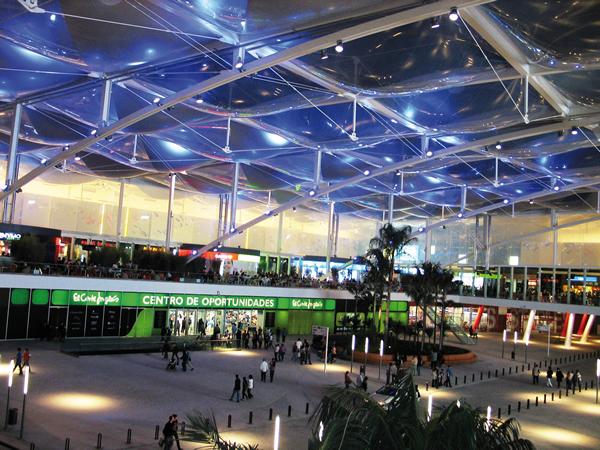
Date: 8 September 2017
The Cooperative Research Project FLEX-G started on June 1, 2017 under the federal construction technology initiative named ENERGIEWENDEBAUEN funded by the German Federal Ministry for Economic Affairs and Energy (BMWi, funding reference 03ET1470A).
The main goal of the research project is to investigate technologies for the manufacturing of translucent and transparent membrane roof and façade elements with integrated optoelectronic components.
The focus lies on a switchable total energy transmittance (often referred to as the solar factor or solar heat gain, and “g-value” in Europe) and on flexible solar cell integration to significantly contribute to both energy saving and power generation in buildings.
Solar modules and a variety of energy management systems are well established in small and large buildings to optimize their energy balance both by generating electrical energy and by minimizing required power for heating, ventilation and air conditioning (HVAC).
A major trend in modern architecture is the use of large transparent and translucent façade and roof elements to make time spent in these buildings more pleasant due to bright and spacious rooms and appearance. When made of glass, these façades and roofs are functionalized with heat reflecting coatings to minimize their “g-value”.
However, glass is not bendable enough to apply it to vaulted surfaces as design element in representative buildings such as airports, stadiums, event halls or shopping malls. Furthermore, its high weight limits the use of glass for large area roofs or façades without massive, expensive and design-limiting supporting structures.
For these applications, fluoropolymers such as ethylene tetrafluoroethylene (ETFE) are an alternative to glass providing a long lifetime and resistance to weathering.
A noteworthy example for the use of this material is the roof of the largest shopping mall in Europe (the Dolce Vita Tejo in Lisbon, Portugal) with its 5-layer diaphanous cushions comprising 200,000 m² of ETFE.
In contrast to glass, fluoropolymers are difficult to handle in thin-film coating processes. For this reason, roof and façade elements of membranous material are rarely functionalized yet with energy-saving features such as thermal shielding layers or integrated solar modules.
Until now, it was not feasible to optimize the energy budget of buildings featuring membrane roof and façade surfaces. A consortium of nine industrial and research partners has been formed to change that situation by functionalizing fluoropolymer web surfaces with optoelectronic components through thin film coating techniques.
The Project Coordinator, Dr. John Fahlteich, summarizes the research plans as follows: “Membrane façade and roof elements will be functionalized with electrochromic films which allow switching of the transmission of visible light and thermal radiation by applying an electrical voltage. The energy required for that is made available through flexible organic solar cells. Within the project FLEX-G, we aim to develop dynamic processing and deposition techniques in a way that they are applicable not only for flexible, membrane based building envelopes but also for glass-based systems.”
Within the project duration of 3-years, FLEX-G will investigate processes that allow the deposition of electrochromic layer stacks directly on an ETFE film surface. The flexibility of the film enables the use of economical, efficient and high throughput roll-to-roll (R2R) fabrication processes.
Finally, a 36 m² large ETFE membrane roof prototype will demonstrate both the electrochromic components for switching the total solar energy transmittance and the flexible organic solar cells for electrical power generation.
With integration of flexible optoelectronic components on vaulted building envelopes FLEX-G will contribute considerably to reducing the primary energy consumption of buildings. This is also in-line with the goal of the German federal government to reduce primary energy consumption in Germany to up 50% by 2050.
About FLEX-G
The FLEX-G research program (BMWi funding reference 03ET1470A) is a joint effort of:
- Fraunhofer-Gesellschaft zur Förderung angewandter Wissenschaften e.V. represented by
- FEP Dresden
- ISC Würzburg
- IAP Golm
- Hochschule für Technik Stuttgart
- Coatema Coating Machinery GmbH
- Hightex GmbH
- Lamilux Heinrich Strunz GmbH
- Heliatek GmbH
- ROWO Coating GmbH
- EControl Glas GmbH & Co. KG
- Nowofol Kunststoffprodukte GmbH
 600450
600450



















Add new comment